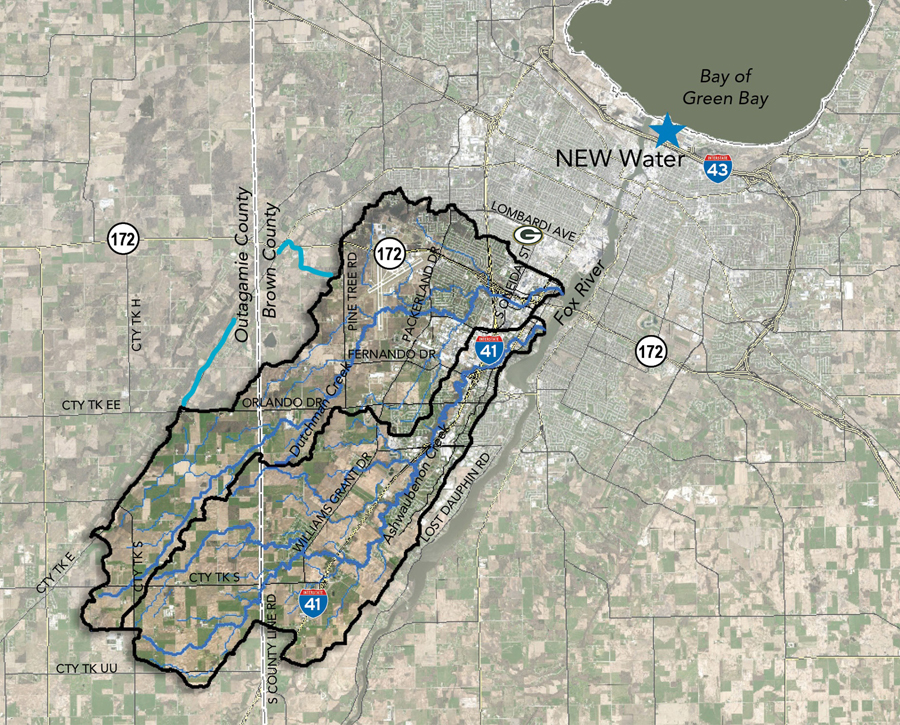
By Rick Cohler
Contributing Writer
GREEN BAY – NEW Water, a wholesale provider of wastewater treatment and conveyance services to 15 municipal customers serving approximately 238,000 residents throughout a 285-square-mile area in the Green Bay area, is in the second year of a 20-year effort to meet Wisconsin Department of Natural Resources (DNR) phosphorus and suspended solids discharge permit limits through an innovative approach.
NEW Water Executive Director Tom Sigmund explains that the DNR issued a total daily maximum load for the lower Fox River from Lake Winnebago to Green Bay in 2012.
The analysis focused on suspended solids and phosphorus and determined where the pollutants were coming from.
Some were coming from municipal and industrial sites which can be relatively easy to regulate, but the bulk of the pollution was coming from rural runoff so the Adaptive Management effort, which concentrates on keeping the pollutants from entering the water was selected.
Spring and fall runoff accounts for 70-80% of all nutrient and sediment loading annually.
NEW Water launched a pilot program in 2014 on Silver Creek with a grant from the EPA’s Great Lakes Restoration Initiative.

“We were able to get a lot of different land management practices installed working with landowners and operators who leased land and we were able to measure water quality improvement in response,” Erin Houghton, NEW Water watershed programs manager, said.
Based on the success of the pilot program, NEW Water negotiated a sub-watershed compliance area for Ashwaubenon Creek and Dutchman Creek, which are both largely in the NEW Water service area.
The plan is expected to cost $71 million over 30 years compared to $88 million to construct a tertiary treatment facility and its needed infrastructure.
During the first permit term, which ends in 2027, the goal is 25% removal of phosphorus and suspended solids.
After the second permit, the goal is 70% removal; after the third permit, it would be 95 percent; and after the fourth permit, 100%.
If the plan can meet the standards and new infrastructure is not needed, that cost would drop to $40 million.
Additional benefits include: “habitat restoration, prevent the loss of soil and nutrients, enhanced economic value of the Green Bay fishery, reduce the impact of the “dead zone” in the bay and attract up to $10 million of outside investment in improved agricultural practices and water quality,” according to NEW Water literature.
The Dutchman Creek area has more than 19,000 acres of which 50.5% is in agricultural use.
Ashwaubenon Creek has about 18,500 acres of which 61.9% is agricultural.
With the larger area, NEW Water set about developing a relationship with agriculture.
“All of this is an exercise in social interaction and a way to bring our best foot forward and build trust,” Houghton said. “We partnered with the Land and Water Conservation departments and the agronomy staffs in Brown and Outagamie counties because they have experience with landowners and with the messaging that goes along with these conservation practices.”
Tilth Agronomy of Hortonville, a private firm that consults with a large number of farmers in Northeast Wisconsin, came along side in helping NEW Water build relationships in the ag sector. The project also overlaps onto the Oneida Nation, which has a number of conservation and environmental programs, and was eager to participate, according to Houghton.
The program is voluntary.
“Were we able to get signed contracts on every single field? No,” Houghton said. “Did we still have some of those ‘nos’ turn into observers and start doing some of those practices by the time we were done? Yes, and we count that as a win.”
NEW Water is able to link landowners to funding through federal, state and other government programs, along with participation by conservation organizations and to date, NEW Water has secured grants totalling more than $2 million.
“Every landowner knows the spots that give him trouble every year and we’re trying to find the overlap,” Houghton said. “They’re looking for solutions too, so we’re trying to find the overlap of our program and what those farmers are trying to accomplish in their business. We’re also working with Austin Straubel International Airport, the Wisconsin DOT, and communities as well because all of us live here, so we all have a place to be part of the solution.”
For more information, visit www.newwater.us.
